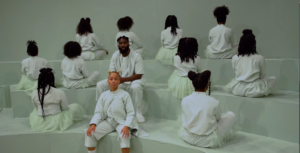(Black History Month) Barbra Jordan
Written By: Artemis Reign of Houston TREND
Barbara Charline Jordan was born February 21, 1936 in Houston, Texas’ Fifth Ward.  She was the daughter of a Baptist minister and a “domestic worker†that graduated with honors from Wheatley High School in 1952. Upon entering college she was not able to attend The University of Texas at Austin because of segregation and instead chose Texas Southern University, majoring in political science and history. She was a national champion debater, defeating her opponents from such schools as Yale and Brown and tying Harvard University. She graduated magna cum laude in 1956. At Texas Southern University, she pledged Delta Sigma Theta sorority. She then attended Boston University School of Law, graduating in 1959. Jordan taught political science at Tuskegee Institute in Alabama for a year. In 1960, she returned to Houston, passed the bar and started a private law practice.
 Unsuccessfully in 1962 and 1964, Jordan campaigned for the Texas House of Representatives. Her persistence won her a seat in the Texas Senate in 1966, becoming the first African American state senator since 1883 and the first black woman to serve in that body. Re-elected to a full term in the Texas Senate in 1968, she served until 1972. She was the first African-American female to serve as president pro tem of the state senate and served one day, June 10, 1972, as acting governor of Texas.
Unsuccessfully in 1962 and 1964, Jordan campaigned for the Texas House of Representatives. Her persistence won her a seat in the Texas Senate in 1966, becoming the first African American state senator since 1883 and the first black woman to serve in that body. Re-elected to a full term in the Texas Senate in 1968, she served until 1972. She was the first African-American female to serve as president pro tem of the state senate and served one day, June 10, 1972, as acting governor of Texas.
In 1972, she was elected to Congress, the first woman to represent Texas in the House in her own right. She received extensive support from former President Lyndon B. Johnson, who helped her secure a position on the House Judiciary Committee
In 1973, Jordan began to suffer from multiple sclerosis. She had difficulty climbing stairs and she started using a cane and eventually a wheelchair. She kept the state of her health out of the press so well that in the KUT radio documentary Rediscovering Barbara Jordan, President Bill Clinton stated that he wanted to nominate Jordan for the United States Supreme Court, but by the time he could do so, Jordan’s health problems prevented him from nominating her. Jordan later also suffered from leukemia.
In 1974, she made an influential, televised speech before the House Judiciary Committee supporting the process of impeachment of Richard Nixon, Johnson’s successor as President. In 1975, she was appointed by Carl Albert, then Speaker of the United States House of Representatives, to the Democratic Steering and Policy Committee.
In 1976, Jordan, mentioned as a possible running mate to Jimmy Carter of Georgia, became instead the first African-American woman to deliver the keynote address at the Democratic National Convention. Her speech in New York that summer was ranked 5th in “Top 100 American Speeches of the 20th century” list and was considered by some historians to have been among the best convention keynote speeches in modern history. Despite not being a candidate, Jordan received one delegate vote for President at the convention.
Jordan retired from politics in 1979 and became an adjunct professor teaching ethics at the University of Texas at Austin Lyndon B. Johnson School of Public Affairs. She again was a keynote speaker at the Democratic National Convention in 1992.
In 1994 and until her death on January 17, 1996, Jordan chaired the U.S. Commission on Immigration Reform, which advocated increased restriction of immigration, called for all U.S. residents to carry a national identity card and increased penalties on employers that violated U.S. immigration regulations. Then-President Clinton endorsed the Jordan Commission’s proposals. While she was Chair of the US Commission on Immigration Reform she argued that “it is both a right and a responsibility of a democratic society to manage immigration so that it serves the national interest.†Her stance on immigration is cited by opponents of current US immigration policy who cite her willingness to penalize employers who violate US immigration regulations, to tighten border security, and to oppose amnesty or any other pathway to citizenship for illegal immigrants and to broaden the grounds for the deportation of legal immigrants.
 Jordan’s partner of close to 30 years was Nancy Earl. Jordan met Earl, an educational psychologist who, in addition to being Jordan’s partner would become an occasional speech writer, on a camping trip in the late 1960s. Jordan never publicly acknowledged her sexual orientation, but in her obituary, the Houston Chronicle mentioned her long relationship with Earl. However, one of Jordan’s biographers, Mary Beth Rogers, neither confirmed nor denied that the former congresswoman was a lesbian, commenting that there were many reasons to explain why Jordan was so intensely private about her personal life. After Jordan’s initial unsuccessful statewide races, advisers warned her to become more discreet and not bring any female partners on the campaign trail.
Jordan’s partner of close to 30 years was Nancy Earl. Jordan met Earl, an educational psychologist who, in addition to being Jordan’s partner would become an occasional speech writer, on a camping trip in the late 1960s. Jordan never publicly acknowledged her sexual orientation, but in her obituary, the Houston Chronicle mentioned her long relationship with Earl. However, one of Jordan’s biographers, Mary Beth Rogers, neither confirmed nor denied that the former congresswoman was a lesbian, commenting that there were many reasons to explain why Jordan was so intensely private about her personal life. After Jordan’s initial unsuccessful statewide races, advisers warned her to become more discreet and not bring any female partners on the campaign trail.
She received the Presidential Medal of Freedom, among numerous other honors and on her death she became the first African-American woman to be buried in the Texas State Cemetery.










